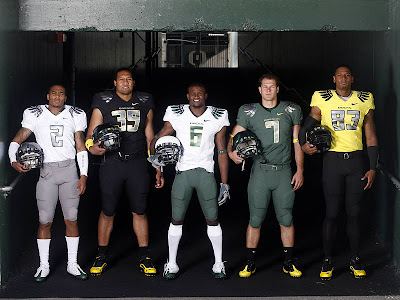The off-the-field issues complicate things for one of the foremost athletic departments in college sports. With the support of alumnus Phil Knight, the founder of Nike, the University of Oregon has established itself as a leader in the development of collegiate sportswear - the football team had the option to wear 80 different uniform combinations during 2009 season. Beginning in January, the school put itself on the map with the most ostentatious of student-athlete development centers, designed - in part - to help resuscitate the football team's woeful 49 percent graduation rate.
Feel free to count for yourself.
Opened on January 6, 2010, the University's John E. Jacqua Academic Center for Student Athletes has been dubbed "the Taj Mahal of academic services." Stretching out over three floors, the 40,000 square foot structure, whose cost has been kept under wraps but was financed with a gift from Knight, features white oak floors and trim, an auditorium paid for by former Oregon and NFL QB Joey Harrington, stylish furniture, an open-air gas fireplace, "acres of iMacs," and a host of other features reminiscent of a modern art museum.
In case you're wondering, Jaqua, who helped found Nike,
has his name on a campus concert hall and the law library.
The building facade is made of glass, as studies show that
access to sunlight can aid learning.
Three-story atrium inside the JEJACSA.
This light sculpture of Phil Knight sits in the ladies restroom.
Don't act like you're not impressed.
Anyone else see Beaker the Muppet in this photo?
Where's the NCAA-required three-story Einstein collage, you ask?
UO's is comprised of photos of the school's athletes.
Joey Harrington's auditorium. Not sure what will happen when it turns pro.
Custom engraved computers.
Quite simply, the pictures speak for themselves. The building, for all its splendor (that's the right word, don't you think?) has angered some students and faculty members. For many, there is a concern that the Jacqua Center is too exclusive. The only spaces that non-student-athletes or professors can take advantage of are some first floor tutoring areas and a coffee shop.
For others, the concerns are far more substantive. Geography professor Peter Walker has referred to the center as "a symbol of this University's wrong priorities." Furthermore, in an article for the school's independent newspaper, Walker is quoted as saying:
"This University has the lowest faculty salaries of any comparable university in the country, and the highest-per-student-athlete expenditures. That is more than a coincidence - it speaks to our University's priorities, which have become backwards from what a quality university should be. Top-quality professors have been leaving this University for years because of the bad salaries. That hurts the quality of the education available to student-athletes and non-student-athletes alike. The irony is that we're headed toward a five-star 'Academic Center' at Jaqua with a two-star academic program. That doesn't benefit anyone, including the student-athletes."A summary of this post leaves a host of questions. First, is the Jaqua Center evidence of the University of Oregon placing athletics over academics? If it is, what is the long-term effect of such an arrangement? Is it right for centers of education to place such a high priority on athletics? Or, is this just a development of the relationship between sports and media? Given the incredible amount of money for appearing on television (see ESPN's recent SEC football contract) or in bowl games, can universities be faulted for their "wrong priorities"?
Second, does a university have the right to do whatever they want with money from incredibly-rich donors like Knight and Jaqua? Should professors and students be prohibited from taking advantage of the University's most advanced academic facilities?
Finally, and most importantly, why is there a light statue of a grinning Phil Knight in the ladies bathroom?












No comments:
Post a Comment